We test the Scott Spark 2022, the most desirable mountain bike of the moment
Few MTB launches have had as much expectation as the new Scott Spark 2022. Rivers of ink flowed even before its presentation. The renewal of the most successful XCO bike in recent years comes with innovations and new concepts that threaten to become a trend. We have had the chance to test the new Scott Spark RC Team Issue AXS for several weeks and to try it out on all terrains. Here you can find all our conclusions.
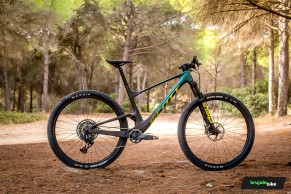
Scott Spark RC Team Issue AXS. Maximum integration in search of performance
Rarely a frame has brought so many new developments at the same time. The most striking feature is undoubtedly the shock absorber hidden inside the frame, but the new Spark has many other innovations that could be trend-setting. Starting with the location of the shock absorber, the first thing we think when we see it is that it seems incredible that it can be hidden in such a small space, but it is. And that doesn't make it any more complicated to adjust.
It's worth mentioning that the previous version of the Spark already changed the location of the shock absorber from under the top tube, like most lightweight XC bikes, to upright next to the seat tube. The aim was to lower the centre of gravity as much as possible, thereby improving the bike's handling and stability.
RECOMENDADO

How to wash your cycling clothes? 10 keys to make them always look new

The real importance of signing up for a race
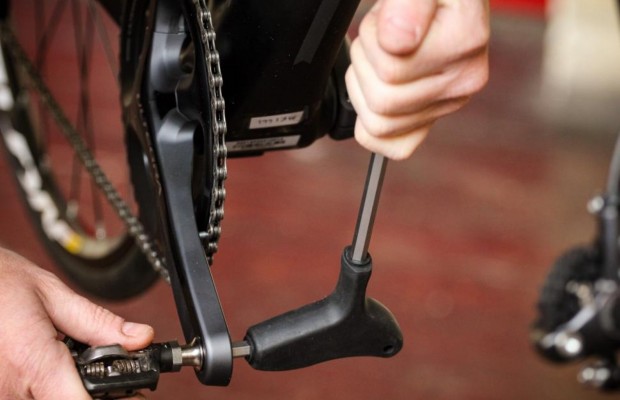
How to change the pedals of any bike in 5 steps
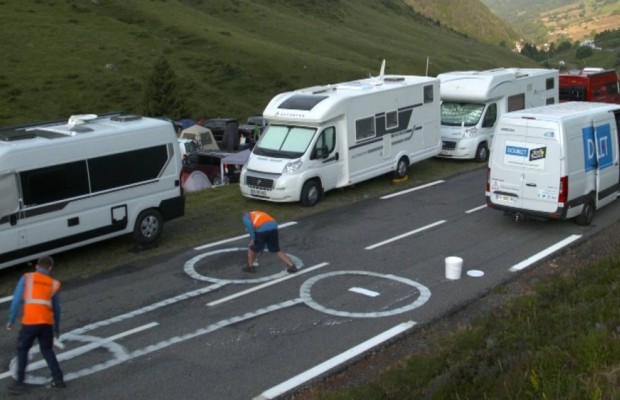
This is how they erase the penises that are drawn on the roads of the Tour de France
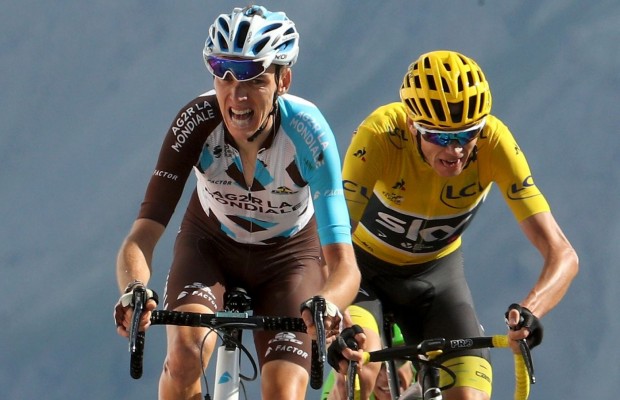
How to lose body fat? Differences between losing weight and losing fat
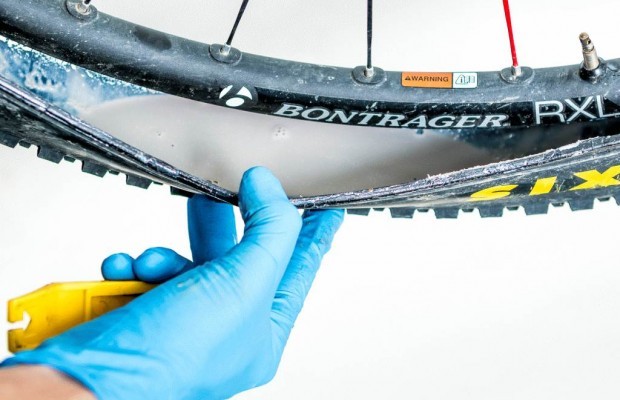
When must the tubeless tire sealant be replaced? What quantity?
The new Spark is a further step in the same direction, as it is integrated into the frame in such a low position that the centre of gravity is lowered even further.
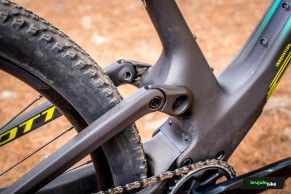
But having the shock absorber inside the frame also offers other benefits, such as complete protection from dust, mud and dirt. And something that for some cyclists is not very important but for others is of capital importance, and that is the fact of being able to hold two water bottles in the main triangle.
With these advantages in mind, it is clear that if the rear suspension performs as well as in the previous Spark, the improvement is more than obvious.
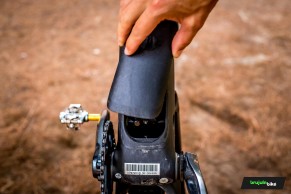
At the bottom of the down tube there is a large window that opens easily without any tools. From this opening we have very convenient access to the air valve and we can also adjust the rebound of the suspension, as well as change the TwinLoc cable and adjust the compression on models with this adjustment.
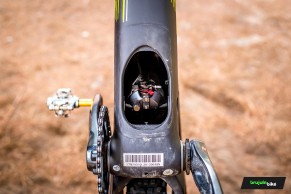
To adjust the sag there is a guide next to the linkage joint which makes the operation extremely simple.
We also have a small rubber cap on the seat tube from which we can check and reposition the o-ring on the shock absorber to see how much travel we are using.
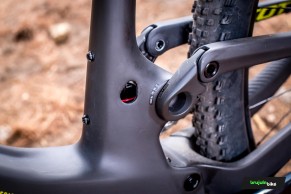
Anecdotally we have to say that after the first tests we noticed some slack in the swingarm, which turned out to be the upper shock absorber mount. This allowed us to see first hand how easy it is to access it. Just by removing the pressure we were able to access through the window of the vertical tube to retighten it. This operation is done with a torque spanner, but we were also able to check that in case of need it can be accessed with the key of the rear lock.
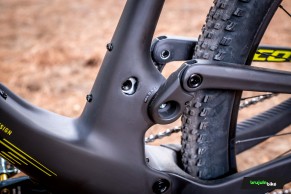
Another of the great new features is the increase in travel that reaches 120mm, seeking to respond to the increasingly technical circuits that we find today in the World Cup and more and more in the rest of the XCO competitions.
There are also other details worth mentioning in the frame design, for example the main pivot point of the swingarm. Here, instead of the chainstays being anchored to the outside of the frame, it is the other way around. The chainstays at the front are joined together to form a solid piece that fits into a recess in the frame, giving the impression of maximum solidity. And they have finished it off by designing a tab that prevents dirt from entering the area.
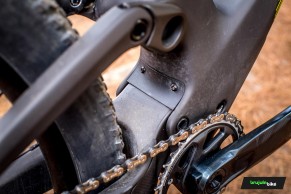
The new Spark also features cable integration through the steering. The area is oversized and, with the help of plastic parts that adapt to the shape of the stem, allow the cables under the stem to enter the inside of the head tube. This way the frame remains intact in this area and no holes are drilled in it, resulting in a very clean aesthetic finish.
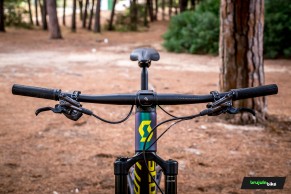
And at the same time, with this new headset design, Scott offers the possibility of mounting cups that vary the steering angle by +/-6º with respect to the 67.2º that the frame has as standard.
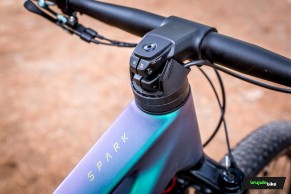
Following on from the new features of the Spark 2022, it is worth mentioning that the chain line has been moved up to 55mm, in order to provide ample clearance for the tyre and to allow the mounting of chainrings with up to 40 teeth.
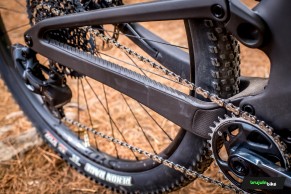
To top it off in terms of small improvements we find a new chainstay protector with a knurling that makes it very quiet and a new removable lever on the rear lock that now includes three keys in one, T25, T30 and 6mm allen, with which we can adjust almost everything on this bike.
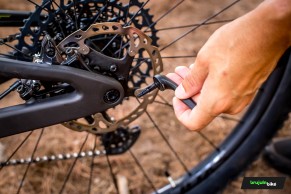
The Scott Spark 2022 takes another step forward in the new XCO geometry
If the previous version of the Spark revolutionised the geometry trend in cross country bikes, this new version goes one step further.
We are used to hearing concepts such as "Down Country". XC has evolved a lot in recent years and it is no longer enough for a bike to be light and efficient in pedalling. The downhills on the new circuits are really technical and vertiginous and the bikes have adapted to this.
And this is good news even for the amateur biker, as competition bikes used to be uncomfortable and nervous, and for the less experienced amateur they could be difficult to ride. But today's geometries are the opposite, they are just as good for fighting for World Cup victories as they are for enjoying MTB without competitive pretensions.
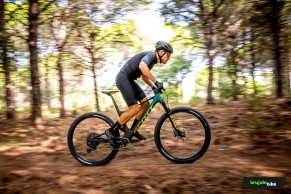
The new Scott Spark 2022 has a steering angle of 67.2º, with the particularity that Scott, taking advantage of the oversized head tube, has designed cups that can vary this angle by +/-6º. Although fitted as standard on this model it comes with neutral cups that do not vary the angle.
The seat tube angle has also been moved up significantly to 76.1° for size M (76.6° for size L).
Also the reach, as has become the trend, has been increased to 441mm in size M and 471mm for size L.
The result of these measurements gives a very long wheelbase. In size M it is 1159mm and 1190mm for size L.
The bottom bracket height is an interesting fact due to the increase in travel, but we can see that it is barely a centimetre higher than the previous Spark and is in line with the height of other models with 100mm of travel.
Assembly of the Scott Spark RC Team Issue AXS
Focusing on this model, we can see that it is assembled with a lot of criteria, considering its price, they have managed to dress it up with a RockShox SID and a wireless Sram AXS groupset, which is not bad at all.
The fork is the Rock Shox SID Select RL3, with its robust frame with 35mm bars that provides the necessary stiffness to a bike that will allow us to go into somewhat wilder terrain than usual in an XC.
The shock absorber on this model is also made by RockShox, of course in a TwinLoc compatible Nude version.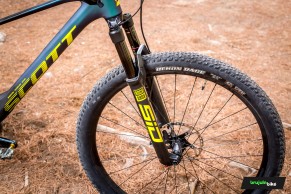
The wheels fitted to the Team Issue are, as usual, the brand's own. They are Syncros Silverton 2.0, with an asymmetric aluminium rim of 30mm internal width to accommodate the thick 2.4" Maxxis Rekon Race tyres without any problems.
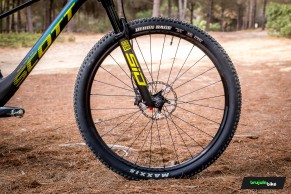
The Sram GX Eagle AXS groupset is used in its entirety with the exception of the brakes, opting for the 10-52 cassette and 32-tooth chainring, and also relies on the new Rocker pushbutton.
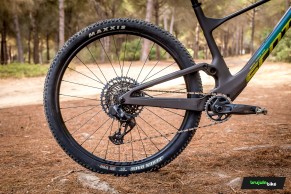
The brakes are Shimano XT M8100 with 180mm discs at the front and 160mm at the rear, which guarantee great power and stability.
The rest of the components are by Syncros and are quite correct, with special mention to the stem that is designed to favour the entry of the cables underneath it and they have done it with a very attractive design and a very robust appearance.
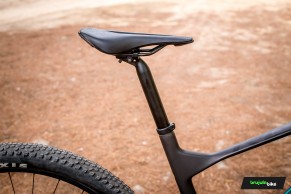
We also liked the fact that we don't see anything on the handlebar other than the brake clamps, as the new TwinLoc is anchored to the brake lever and the Sram AXS pushbutton does the same.
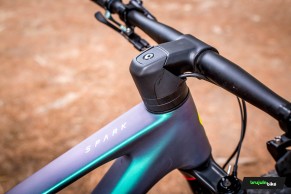
And one detail that we didn't like at all is that there is no steering lock. You have to be very careful when handling the bike, as the levers hit the top tube squarely. It is true that until recently it was rare to find these stops, but it so happens that at the same time that the very sharp steering angles stabilise the steering when riding, when stationary the opposite happens and the handlebars turn with astonishing ease.
120 millimetres of pure Cross Country
The long awaited moment to get behind the controls of the new Scott Spark 2022 has arrived. Our test unit was a size L and normally we fit better in a M. But even so, we didn't feel any discomfort and we didn't ride in a forced position. We have already commented in other tests that the new geometries, despite greatly increasing the reach, compensate for it with short stems, as in this case that in size L has a 70mm stem. The vertical seat tube also puts you in a very advanced position and close to the handlebars.
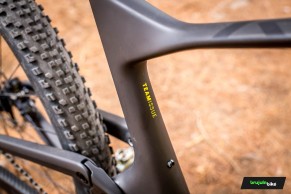
Right from the start we were already looking for varied terrain to see how this new geometry affects us and, above all, how the increase in travel to 120mm on both wheels feels. And so, by way of introduction, we have to say that we noticed much more of the former than the latter.
The new Spark feels tremendously stable thanks to its low centre of gravity, low steering throw and long wheelbase (even more so in size L). It's a joy to ride on trails, and when we pick up the speed a little, it feels incredibly poised and confident.
On downhills when the road surface is good, the bike allows us to reach very high speeds and in the curves we notice a grip that seems improper for road tyres like the ones on the bike.
And we say "rolling tyres" because despite their generous 2.4" balloon, the Maxxis Rekon Race tyres roll very well. Mounted on the wide 30mm Syncros rims they allow us to ride with very low pressure and, although it may seem a contradiction, we don't notice any ballast due to friction. In any case, the ball they give us is not so exaggerated. The real width measured with our gauge is 61mm.
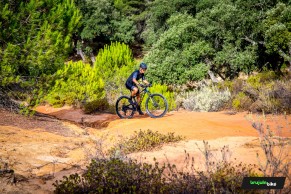
Following on with the sensations that the Scott Spark RC Team Issue AXS leaves us with, we have to say that the suspension feels firm, like any Cross Country bike that is worthy of the name. Perhaps we came with the idea that we would notice too many concessions to comfort due to those 120mm of travel. And that travel is there, but the Spark is a performance focused bike and even with the TwinLoc in open mode there is no excessive sway when pedalling hard. We do notice a lot of bump leakage in open mode, but even on some short ramps where we stand up in open mode, we don't notice a big loss of wattage through the suspension.
We did quite a few tests with the sag and found that the last part of the stroke is very progressive. Even with a little more sag than recommended, we didn't reach the top end. Our conclusion is that the extra travel of the new Spark 2022 is there for when things get really serious.
TwinLoc: Choose which bike you want in each situation
As many of you will already know, the Spark's suspension is controlled by Scott's TwinLoc control. We have to say that we like this new version of the control less than the previous one in terms of ergonomics, although it may just be a lack of habit. Aesthetically it is more compact as it is under the brake lever and is anchored to it, instead of being anchored to the handle like the previous version, which was a bit more bulky.
When it comes to using it, we have found a couple of drawbacks. One is its sensitivity when it comes to unlocking, as it is very easy to overdo it and skip the intermediate position. And the other drawback is the unlocking button itself, which, having changed the pivot point, is not pressed inwards but rather outwards, making it somewhat less natural. It's not serious and you end up getting used to it, but if we had to choose, we'd stick with the previous control.
Having said that, we can only praise the possibility of having three such differentiated behaviours on the same bike.
In open mode we have a great sensitivity and shock absorption capacity. This, along with the new geometry, means that on descents with the new Scott Spark 2022 we really feel that our capabilities have increased. The new Spark is the best downhill XC bike we've tested. The only thing missing from this model is a dropper seatpost to make the most of its qualities.
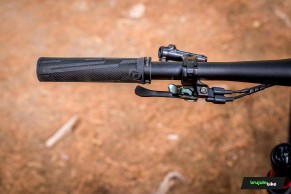
In the intermediate position of the TwinLoc we find the great secret of Scott's Nude system. Not only does the compression of the shock absorber close, but also the positive chamber changes to 80mm of travel. This also means that the sag is slightly reduced and we are in a position that is very favourable for pedalling.
This position is the one we have been using most of the time as it combines very good pedalling efficiency, eliminating most of the sway but with the comfort of shock absorption, giving us unbeatable traction on broken climbs.
And when the terrain is fairly flat, or when we're riding on tarmac, we use the lock. It's a real lock that turns the Spark into a racing bike that transmits every watt we generate.
Scott Spark RC Team Issue AXS: mid-range with a competitive spirit
We have had it as a companion for a few weeks and have enjoyed its goodness and searched for its faults.
Starting with the latter, when we studied its characteristics we assumed that a bike with such a downhill geometry and its long wheelbase would penalise on technical climbs, and so we went looking for the tickle.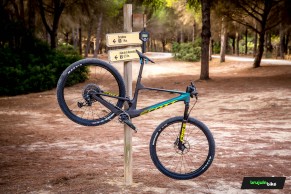
The first thing we noticed is that this particular model is not especially light. Our size L unit, out of the box, weighed 11'970 kg. This weight is with tubes on and without pedals. But once tubed, pedalled and ready to ride it weighed 12.3kg. But although it lacks that extra punch that a superlight bike gives you, the position we adopt on it allows us to harness all our energy and climb with agility.
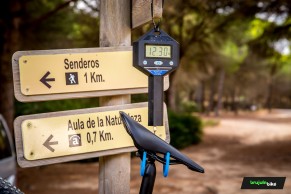
On steep and broken climbs is where you can appreciate the lack of nerve of its steering, it is true that you have to anticipate a little before the movements, but it is something you get used to and its 74 cm handlebars and short stem help you in this sense. This effect is only noticeable when we go very slowly and as soon as we gain some inertia things change completely and we start to feel a manageable but docile and predictable bike.
Its geometry and behaviour give us so much confidence that even in twisty curves, which a priori could be its other weak point, we go into it with determination, knowing that the bike is not going to do anything strange.
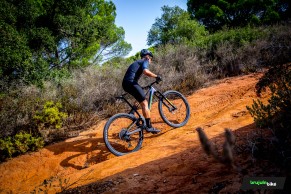
When it comes to high speed, we've already talked about its benefits, and in addition to its geometry and suspension, we have a great Rock Shox Sid Select fork with 35 bars whose stiffness gives us extra safety and control. And when it comes to stopping it, the Shimano XT brakes are a real hit. The power of these brakes is unusual for 2-piston brakes and even on the most vertiginous downhills we feel in control.
Another detail worth mentioning about this bike is how quiet it is. In the many days that we have enjoyed it, there has not been the slightest creak or noise from the movement of the cables. When pedalling you only hear the sound of the tyres on the ground.
On other occasions we have already talked about the Sram GX AXS groupset that the Team Issue mounts in its entirety. The same performance quality as its bigger brothers, just with a little more weight, and we save a cable that, although it would be almost completely hidden, at some point it would have to be checked or changed.
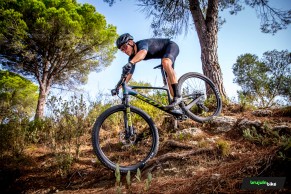
What doesn't convince us every time we try it out is the cassette with a 52 instead of a 50 sprocket. The last jump is more pronounced than usual and we end up avoiding it. However, with this combination of 32-tooth chainring and 52 sprocket, there is no ramp that can resist.
The only thing missing from this model is a dropper seatpost, which would fit in very well with the character of this bike.
Final conclusions
After these weeks at the controls of the Scott Spark 2022 we have been able to corroborate that the new features of this model make sense and are here to stay.
There's no need to be sceptical about the ground-breaking geometry, as it's clearly designed to make the Spark easy to handle and safe to ride. Riding a bike designed for the World Cup has never been easier.
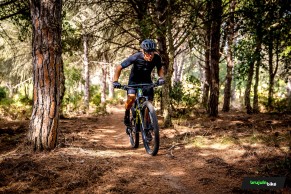
The Team Issue AXS model is in the middle of the RC range. The Spark RC range consists of 7 models, plus a women's specific model. The entry-level price is 3,699€ and goes up to 13,200€ for the exclusive top-of-the-range model.
Frame: Spark RC Carbon HMF
- Fork: Rock Shox Sid Select RL3 120mm
- Shock absorber: Rock Shox Nude 5 RL3 Trunnion 120-80-Lockout
- Rear Derailleur: Sram GX Eagle AXS
- Shifter: Sram GX Eagle AXS Rocker
- Cranksets: Sram GX Eagle DUB 55mm 32T
- Bearing race: Sram DUB PF92 MTB Wide / Shell 41x92mm
- Chain: Sram GX Eagle
- Cassette: Sram XG1275 10-52
- Brakes: Shimano XT M8100 180/160mm
- Handlebar: Syncros Fraser 1.5 XC Alloy 740mm
- Stem: Syncros XC 1.5 -12ºrise
- Seatpost: Syncros Duncan 1.5 10mm offset
- Saddle: Syncros Belcarra Regular 1.5 titanium rails
- Headset: Syncros-Acros Angle adjust & cable routing system
- Wheels: Syncros Silverton 2.0-30
- Tyres: Maxxis Rekon Race 29x2,4” Tubeless Ready / EXO
- Price: 5.299€